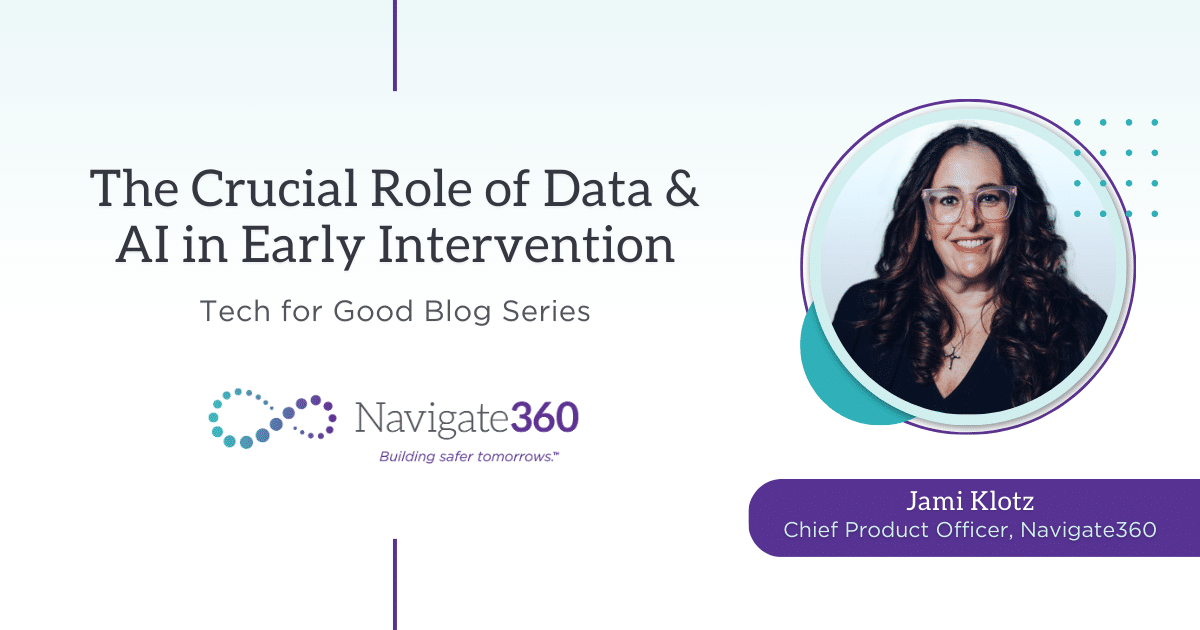By: Jami Klotz, Chief Product Officer, Navigate360
Part 2 of a 6-Part Series
In the ongoing quest for safer schools and the well-being of students, the integration of data and artificial intelligence (AI) emerges as a powerful tool for risk identification and prevention. Part 2 of our series explores how these technologies can play a pivotal role in identifying students at higher risk of self-harm, bullying, or other safety concerns while addressing critical statistics that underscore the importance of early intervention.
Early Identification: A Game-Changer in Student Safety
Current data underscores the significance of early indicators in identifying students at risk. Twenty-plus years ago, teachers overheard conversations or took notes that were passed around a classroom to have a pulse of what is going on with students. Today, there are too many sources for one person or even a small team of people to read and decipher trends. Yet the statistics do not lie, people of all ages still talk about how they are feeling or leverage outlets to show their views and beliefs, providing many clues or early warning signs of upcoming behavior.
By leveraging AI algorithms to monitor social media platforms, online communication channels, and other relevant sources, educational institutions gain a proactive means of risk identification. This early identification opportunity is not only essential for preventing incidents but also for providing targeted support to those who need it most.
Statistics on the Importance of Early Indicators:
- According to a comprehensive school shooting study conducted by the Secret Service and Department of Education, 93% of school shooters planned their attacks in advance.
- Shockingly, in 4 out of 5 school shootings, at least one other person had knowledge of the attacker’s plan but failed to report it.
- Almost all mass school shooters shared threatening or concerning messages or images. According to data from the Secret Service, more than 75% raised concern from others prior to the attacks. Bystanders saw warning signs in most documented active shooter cases.
Addressing Warning Signs: Connecting the Dots with AI
Data reveals that prior to incidents of self-harm, bullying and school mass casualties, warning signs are often present. These signs may include:
- Social Media Expressions: Individuals involved in such incidents may share troubling content, suicidal ideation, or express violent ideologies on social media platforms.
- Behavioral Changes: Shifts in behavior, shifts in attendance, withdrawal, or sudden aggression can be indicative of underlying issues.
- Explicit Threats: Some individuals may issue explicit threats or communicate their intentions in several ways.
- Self-Awareness: There are many times when checking in with a student, either digitally or 1:1, can also help identify pattern changes
Warning signs often go unnoticed due to the fragmented nature of the sources. AI can bridge these gaps by looking at multiple sources and being able to identify trends that are similar to past incidents. Leveraging similar patterns can help identify earlier indicators of behaviors forming, allowing the right people to create opportunities for intervention so that we can strive for zero incidents.
The technology already exists and is leveraged in so many of our day-to-day activities, so not using it to keep our schools safe almost feels negligent. Staff at schools, even with the best intentions, cannot see, hear, and analyze data in real time. They cannot leverage multiple sources to detect early patterns of behavior; however, technology can and that is how we can leverage tech for good and keep students safe. Here are just a few highlights of ways technology can give us a jump start on identifying our students who are most in-need:
- Monitoring Online Communication: Analyzing language patterns, sentiment, and contextual information in online communication channels to detect signs of distress. Large language models that learn as language patterns change and evolve can help society understand when signs of distress, depression, or other concerns are arising.
- Identifying Isolated Indicators: Pinpointing isolated indicators that, when combined, reveal a higher risk of self-harm or suicide. Patterns such as a change in grades, change in attendance, behavior, or speech pattern changes all could be missed in isolation, but allowing technology to combine data and identify patterns across sources, allowing us to provide the best assistance possible for every student and ensuring no students fall through the cracks or go unnoticed.
The ability to assess and connect data from disparate sources allows AI to provide a comprehensive view of a student’s well-being, enabling timely intervention. Technology is the modern-day eyes and ears that will ensure we do not miss our most vulnerable students and enable us to intervene early enough to provide support and options other than self-harm or harm to others.
The Proactive Approach: Empowering Schools to Act Swiftly
In the realm of student safety, a proactive approach is paramount. AI-equipped early identification warnings empower school administrators and counselors to intervene swiftly, offering targeted support that can prevent incidents before they occur. By leveraging the power of data and AI, educational institutions can create safer environments where the well-being of every student is a top priority.
In the next installment of our series, we will delve into how technology can not only help us identify behavior proactively but also create personalized intervention programs that fit the unique needs of each student and each situation. AI in student safety will continue to be increasingly critical. The responsible implementation of technology can ensure the protection of privacy and the promotion of a supportive learning environment, which is a key part of ensuring we can rally around tech for good.

About the Author
Jami Klotz
With over 20 years of experience in product leadership, Jami Klotz has been at the forefront of advancing big data and software products. Her expertise has helped organizations and consumers turn data into actionable insights, while leading both Product and Tech organizations through rapid growth and change in the private equity industry.
Before joining Navigate360, Jami served as Senior Vice President of Product at BigTime Software, one of Inc. 5000’s fastest-growing private companies. There, she built applications used by 2,000 firms to process $4B in billings. Jami’s career spans across several companies that include Travelclick, Orbitz, and nSight Travel Intelligence where she served as President and Chief Product Officer. Throughout her career, she has driven strategic growth, cultivated a strong brand image and defined cohesive and integrated roadmaps driven by market needs.
Jami has been a featured speaker globally on the use of big data in revenue optimization and the use of data to increase value to customers. She believes transparency and team development are key to maximizing results for all stakeholders.
Outside of her professional achievements, Jami has a strong sense of family and community. She currently resides in the suburbs of Chicago with her husband and three children. Outside of family she enjoys volunteering with groups supporting women in need as well as hiking and exploring new destinations.




